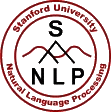
nlp.stanford.edu/sentiment
Preview meta tags from the nlp.stanford.edu website.
Linked Hostnames
11- 7 links tonlp.stanford.edu
- 2 links towww.stanford.edu
- 1 link tocs.stanford.edu
- 1 link toengineering.stanford.edu
- 1 link tojason.chuang.info
- 1 link totwitter.com
- 1 link towww.apple.com
- 1 link towww.google.com
Thumbnail

Search Engine Appearance
Deeply Moving: Deep Learning for Sentiment Analysis
This website provides a live demo for predicting the sentiment of movie reviews. Most sentiment prediction systems work just by looking at words in isolation, giving positive points for positive words and negative points for negative words and then summing up these points. That way, the order of words is ignored and important information is lost. In constrast, our new deep learning model actually builds up a representation of whole sentences based on the sentence structure. It computes the sentiment based on how words compose the meaning of longer phrases.
Bing
Deeply Moving: Deep Learning for Sentiment Analysis
This website provides a live demo for predicting the sentiment of movie reviews. Most sentiment prediction systems work just by looking at words in isolation, giving positive points for positive words and negative points for negative words and then summing up these points. That way, the order of words is ignored and important information is lost. In constrast, our new deep learning model actually builds up a representation of whole sentences based on the sentence structure. It computes the sentiment based on how words compose the meaning of longer phrases.
DuckDuckGo
Deeply Moving: Deep Learning for Sentiment Analysis
This website provides a live demo for predicting the sentiment of movie reviews. Most sentiment prediction systems work just by looking at words in isolation, giving positive points for positive words and negative points for negative words and then summing up these points. That way, the order of words is ignored and important information is lost. In constrast, our new deep learning model actually builds up a representation of whole sentences based on the sentence structure. It computes the sentiment based on how words compose the meaning of longer phrases.
General Meta Tags
3- titleRecursive Deep Models for Semantic Compositionality Over a Sentiment Treebank
- Content-Typetext/html; charset=utf-8
- fb:adminsrsocher
Open Graph Meta Tags
6- og:titleDeeply Moving: Deep Learning for Sentiment Analysis
- og:typearticle
- og:imagehttp://nlp.stanford.edu/sentiment/images/nlp-logo.gif
- og:urlhttp://nlp.stanford.edu/sentiment/index.html
- og:site_nameDeeply Moving: Deep Learning for Sentiment Analysis
Link Tags
1- stylesheetstyle.css
Emails
1- [email protected]?Subject=Comments
Links
18- http://cs.stanford.edu/people/ang
- http://engineering.stanford.edu/news/stanford-algorithm-analyzes-sentence-sentiment-advances-machine-learning
- http://jason.chuang.info
- http://nlp.stanford.edu/manning
- http://nlp.stanford.edu/~aperelyg